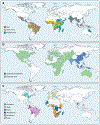The continued threat of emerging flaviviruses
- PMID: 32367055
- PMCID: PMC7696730
- DOI: 10.1038/s41564-020-0714-0
The continued threat of emerging flaviviruses
Abstract
Flaviviruses are vector-borne RNA viruses that can emerge unexpectedly in human populations and cause a spectrum of potentially severe diseases including hepatitis, vascular shock syndrome, encephalitis, acute flaccid paralysis, congenital abnormalities and fetal death. This epidemiological pattern has occurred numerous times during the last 70 years, including epidemics of dengue virus and West Nile virus, and the most recent explosive epidemic of Zika virus in the Americas. Flaviviruses are now globally distributed and infect up to 400 million people annually. Of significant concern, outbreaks of other less well-characterized flaviviruses have been reported in humans and animals in different regions of the world. The potential for these viruses to sustain epidemic transmission among humans is poorly understood. In this Review, we discuss the basic biology of flaviviruses, their infectious cycles, the diseases they cause and underlying host immune responses to infection. We describe flaviviruses that represent an established ongoing threat to global health and those that have recently emerged in new populations to cause significant disease. We also provide examples of lesser-known flaviviruses that circulate in restricted areas of the world but have the potential to emerge more broadly in human populations. Finally, we discuss how an understanding of the epidemiology, biology, structure and immunity of flaviviruses can inform the rapid development of countermeasures to treat or prevent human infections as they emerge.
Figures




References
-
- Gubler DJ Dengue/dengue haemorrhagic fever: history and current status. Novartis Found Symp 277, 3–16; discussion 16-22, 71-13, 251-253 (2006). - PubMed
Publication types
MeSH terms
Grants and funding
LinkOut - more resources
Full Text Sources
Other Literature Sources

